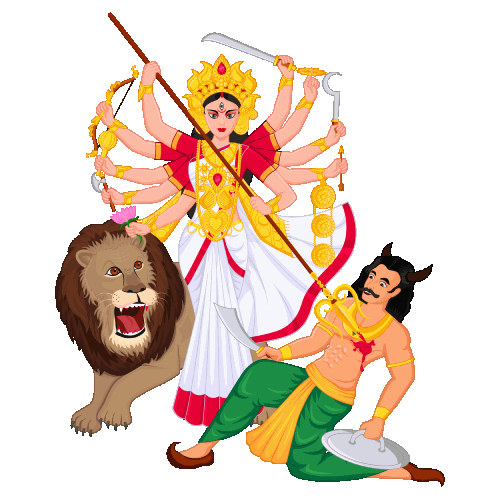NAVRATRI : THE FESTIVAL OF SPREADING JOY AND UNCONDITIONAL LOVE

Navratri is major festival in India. Which is held in honour of the divine feminine. The festival’s name itself describes the festival as ‘Nav’ means nine and ‘Ratri’ means night. Hence the festival lasts for 9 nights and it often ends with the Dussehra which also known as ‘Vijayadashmi’. The festival is celebrated differently in India’s various regions. For many of the people it is a time of religious reflection and fasting. While for other people it is a time for dancing and feasting. May ritual which is ‘kanya Puja’ It takes place on the eighth or ninth day. In which nine young girls are dressed as the nine goddess and are worshipped with ritual of foot washing and offerings such as food and clothes.
Navratri is a festival when Hindus celebrate the goddess Durga for killing the demon, Mahishasura. Lord Brahma, had blessed Mahishasura with the gift of immortality because of his dedication to him, which meant he could never die. However, Lord Brahma set one condition before him which is – The only person who would be able to kill Mahishasura would be a women. Mahishasura didn’t think any women would be strong enough to defeat him and he was happy with deal.
Over the years, Mahishasura and his men become a powerful force and started attacking people on earth and no god were able to defeat him. Finally Lord Brahma, Vishnu and Mahesh (Shiva). The three most powerful gods decided to come together and create the goddess Durga, a powerful women, who’s job would be to destroy Mahishasura. Before she went into battle with Mahishasura, the God equipped the Goddess Durga with lots of weapons.
Durga fought with the demon Mahishasura for 10 days and it proved quite difficult as he kept changing his form to confuse the goddess Durga. However, he finally formed into a buffalo. Durga was able to kill him.
The nine days of Navratri are usually dedicated to the nine avatars of goddess. Which are as follow :
- The first day, Shailputri is an incarnation of goddess Parvati she rides the Nandi with Trishul and Lotus in her hand.
- The second day, Brahmachrini, which is another incarnation of goddess Parvati or her unmarried self. Symbolises calmness and peace and is holding Kamandal and Japmala.
- The third day, Parvati on marriage to Lord Shiva wore the half-moon on her forehead, and Chandraghanta is the depiction of this form of goddess.
- The forth day, Kushmanda is the creative power of the universe. She rides a tiger and depicted with eight arms.
- The fifth day, Skandamata, who is mother of Lord Skanda or Kartikeya. She depicts the strength of a mother when her children are in danger. She rides a lion with her baby in her arm.
- The sixth day, Katyayani is a warrior goddess and is depicted with four arms. She rides the lion and symbolises courage.
- The seventh day. Mahakali, is the most violent form of goddess Parvati attained on removing her fair skin to destroy the demons Sumbha and Nisumbha.
- The Eight day, Mahagauri, the goddess depicts peace and optimise on this day.
- The ninth day, Goddess Sidhidatri sits on lotus and has power of the Sidhis. She radiates the beauty of nature and wisdom. Also referred to as Saraswati Devi.
Navratri celebrated in all over the India. In North India, Navratri is celebrated as the victory of Rama over the evil demon king Ravana. It concludes in the celebration of the Ramli which is enacted ceremoniously during Dussehra . The Statue or idol of Ravana, Kumbhakarana are burnt to celebrate the victory of God over Evil force on the ‘Vijayadashmi’ day.
In Western region of India, particularly in the state of Gujrat, Navratri festival is celebrated with the famous Garba and Dandiya – Rass Dance. Garba is a grateful dance form, where in women dance gracefully in circles around a pot containing a lamp. Besides the Dandiya Dance in which men and women participate in pairs with small decorated bamboo sticks which called Dandiyas in their both hand.
In West Bengal and North East India the last five das of Sharad Navratri is celebrated as Durga Puja. Goddess Durga is shown with various weapons in her hand riding on lion. The weapons denote the focus and severity needed to destroy the negativity in our minds and the lion signifies the Dharma the will power. These idols of goddess Durga are then worshipped for five days and immersed in the river on the fifth day.
Navratri is the time to invite people, friends, relative and neighbours over to look at the Kolu, which is essentially an exhibition of various dolls and figures. In Southern part of India, Yakshagana, a night-long dance in the form of epic dramas form our Puranas are enacted during the nine nights of Navratri. The Navratri is referred as Dasara is Karnataka. The Mysore Dasara is celebrated with celebration and show depicting the triumph over evil.
In the end, Navratri festival is really about reconnecting with something much bigger than us and these rituals are tools that help us to do that moreover, these nine days have been given to us to rejuvenate, rest and connect with ourselves which in turn helps us connect better with our loved ones and enjoy the life.
Vidhi K. Joshi
B.A. LL.B – II
S.S. Maniyar Law College, Jalgaon
